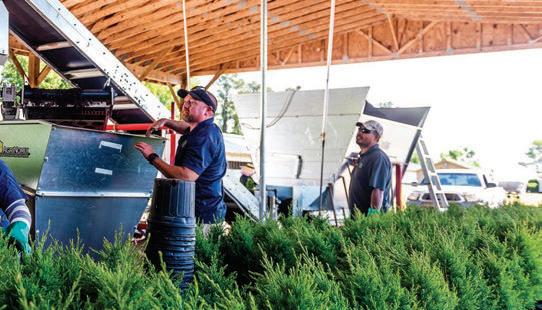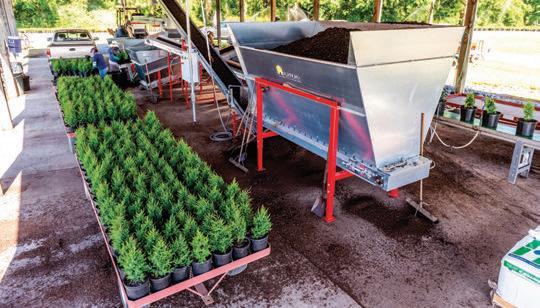
10 minute read
Old Courthouse Nursery Increases Productivity with Automation
By Anthony V. LeBude, Ph.D. Associate Professor, Nursery Crops Extension and Research NC State University
Photos: Bryan Regan
Advertisement
Aworking group of nursery faculty from major universities were on a conference call with growers from around the country to learn about their priorities, challenges and the top issues they thought we should tackle for a recent grant proposal. We talked for an hour about various topics, including pest control, shipping, definitions of quality and business expansion. Then, we politely we asked if labor was an issue. They all erupted into laughter for about 30 seconds. “Hell, if we knew you were interested in labor, we would have said that hours ago,” replied one of the participants. “We didn’t think you cared about that or could do anything about it. It’s our number one cost and our biggest challenge to maintain.” They are right, labor is a contentious issue full of pitfalls, policy, competition and shortages, and it is the biggest cost for the green industry.

Old Courthouse Nursery Production Manager Bryan Naylor (left) and General Manager Jeff Allegood (right).
Green Industry Economic Impacts
The results of a 2013 national survey found that the U.S. green industry and its input purchases were responsible for approximately $200 billion in revenues annually and supported over two million jobs, or 1.1% of all jobs in the nation.
The foundation of this sector of agriculture is nursery production of trees, shrubs, vines, groundcovers and perennials, which exceeds $16.7 billion in economic impacts. In 10 states, the green industry was responsible for 1% of gross domestic product (GDP) and 1.25% in five states. North Carolina was one of those states.
Employment contributions averaged 0.6 jobs/ square mile of land area and 6.4 jobs per 1,000 persons in the U.S. population, while GDP contributions averaged $34,176/mile2 and $382 per capita. Since the Great Recession of 2007-08, green industry contributions in 2013 increased by 4.4% for employment and 2.7% for GDP in inflation-adjusted terms. Growth in the industry was highest for wholesale and retail trade, whereas production and manufacturing declined.
Essentially, the green industry is a vital contributor to both state and national GDP and is responsible for providing many rural jobs and improving economic impact in those communities. Finding and retaining full- and part-time labor is the main challenge to remaining profitable. In some cases, it prevented the nurseries we spoke with from expanding because they could not find anyone to manage and work in the newly constructed growing areas.
Using Machinery to Increase Labor Outputs
Uncertain labor situations combined with the inability to expand have driven some producers to consider mechanization or automation for some nursery tasks. These decisions are not taken lightly because of

planning, changes to workflow, employee morale and the cost to purchase and install new equipment.
When nurseries were originally constructed, producers may not have envisioned using a potting machine, so adding one would require considerable retrofitting to suit the original layout. There are other barriers that affect growers’ purchasing decisions, which include taking on more debt, laying off workers, being the first nursery in a region to adopt a new technology, and simply, fear of change. Potting machines are one piece of technology that could affect every aspect of production in a container nursery since every plant has to be potted.
References Hodges, A.W., C.R. Hall, M.A. Palma, and H. Khachatryan. 2015. Economic contributions of the green industry in the United States in 2013. HortTechnology 25:805-814. Access at https://doi.org/10.21273/HORTTECH.25.6.805.

A Conversation with Old Courthouse Nursery
NC State Nursery Crop Science spoke to Jeff Allegood, general manager of Old Courthouse Nursery, a large propagation and container nursery in Warsaw, N.C., about his nursery’s recent purchase of a potting machine. The conversation highlights a few challenges, unintended consequences and his clearer vision for the nursery with the addition of the equipment.
When did you decide to install a potting machine?
We have been looking for ways to get more done with less labor, and get potting done more efficiently, for years. We had decided we wanted to add a potting machine to our operation several years back but then the hard freeze of 2018 hit, and we lost a ton of plants. We could have purchased several potting machines with the dollar value of what we threw away, so we had to put our plans on hold. We had a strong 2019 and finally had the funds to pull the trigger. We got it set up and installed in late 2019 and started using it in early 2020.
Did you do any research beforehand to help you decide?
Most of our research was asking other nurseries what they have experienced and what had and had not worked for them, to see how it related to what we needed to get done (container sizes that machines could handle, scale of operation in both numbers of plants and amount of labor, etc.). We also asked them about the durability of their machines, customer service and support after purchase, and availability and turnaround on parts and service.
We plan on having the machine for a long time, so we wanted to make sure we got one that matched our needs. NCNLA member Hunter Latham at Latham’s Nursery uses a lot of AgriNomix™ (Machine Tools for Growers)

products and he let us visit to see his machine running. You can only get so much out of watching videos and looking at CAD designs, but talking to him and seeing a machine like we wanted actually running sealed the deal for us.
We also talked to the manufacturers and their salespeople, but of course, they all want to sell you their product, so you have to consider that with what they are telling you. You can get good information from them, like prices and references to people who are using their product, but we prefer to talk to the nurserymen and women who are actually running equipment in the real world to see how they work. You get more useful information (good and bad) from people who are actually using the equipment in a real-world setting.
What benefits did you think the potting machine would provide your nursery?
We are hoping the potting machine will let us shrink the window of time it takes to get potting completed. Using less labor and running more efficiently will help in any industry, but with nursery production, you also gain growing time sooner in the season if you are able to get something potted up. If we can get all of our liners potted to one gallons by early summer versus late summer then those plants get more growing time, so they are better prepared for winter and will be finished and sellable sooner. If one-gallon plants finish earlier than previous scheduling, we can pot them to three gallons sooner, which lets them finish sooner and so on. We shorten the overall production timeline and have quality plants earlier than before.
How were you potting plants previously?
A hopper, filled by a skid steer loader, gravity fed our mix down to a flat deck. The deck had interchangeable inserts for different sizes of pots (e.g., one to seven gallons, we did not use it for our 15- or 25-gallon pots). The pot sat on the insert and was flush with the deck so you could pull soil into the pot by hand, tamp it in and then take the plant to trailers to be watered in and taken out to the field. The new machine makes our old system look inadequate and antiquated.
Is there a difference in labor between the two systems?
In the short period of time we have used it, we have seen that a 10-person crew running the potting machine is turning out the same number of plants in one day as a 14-person crew did before we got the machine. If we had 14 people running the potting machine,

we think we could get 35-45% more plants potted per day.
What are you going to do with your labor if it requires fewer people to pot plants, or you complete potting earlier?
Getting potting finished earlier frees up labor to help with other production tasks like pruning, spacing, etc. If we can finish the bulk of our potting and then shift that labor to production by mid-summer, then it will help us catch up on other tasks earlier and add value to plants sooner or possibly to other plants we wouldn’t normally touch. The potting machine should help us in lots of ways other than just improving the actual efficiency of potting. That is the plan anyway, but we will see how things play out in reality through the course of the year in 2020 and beyond.
Are you concerned about morale, laying off workers or disgruntled employees?
Our employees took to it quickly and have really liked it. We were worried they may resist it or feel like we were trying to cut them out with mechanization, or run them to death with the speed of the conveyors, etc. They can see that they are getting more done in less time with less physical work and they still have their jobs, so there has been no real resistance to it at all. As a manager I always want to improve production, but I also want my employees to be happy and be on board with changes we implement so it looks like I will get both with this upgrade.
Any unintended consequences as a result of adopting the technology?
A machine like this speeds everything up so you have to adjust on the front end feeding it substrate and on the back end moving the plants out or else you will limit what you can get out of it. We had to buy more tracking trailers to help keep up with the plants the machine turns out and will probably have to get more Kubota RTVs or trucks for pulling trailers to keep up.
What about hidden installation costs?
Luckily, we already had a big pole barn and concrete pad in place, so we did not have that cost with the potting machine project. We knew three-phase would be expensive, but then the actual wiring of the barn cost just as much as getting the three-phase power installed. It also took forever to get the contractor to install the three-phase. It is important to plan ahead if you are going to need power upgrades for your project.
Any more plans for technology adoption now that you can see the future clearer with this machine?
One good thing about this system is that it has many compatible upgrades and options you can add later. After we see how our one-gallon potting goes this year we may decide to add an auger/drill attachment to open holes in the bark for potting plugs. We may look at bumper tables and forklifts at some point, but that would be another big investment so that is probably further out. Additionally, adding conveyors to our truck loading process would cut down on the time and labor used to carry plants into trucks.
Have other growers talked with you about adopting automation since you installed this equipment?
I tell everyone they are welcome to come see what we are doing and will answer any questions we can. We learned a lot from other people in our research for this project (and in the nursery industry in general), so we are happy to help other people if we can. The main thing I tell people is to explore lots of options to make sure they get something that fits their operation and production. Nurseries are all so different, something that works great for one operation might not work well for someone else.



